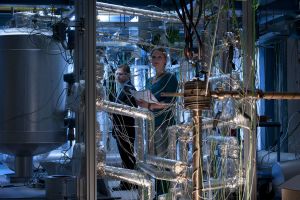Liquid metals are the research focus of the new Helmholtz Alliance LIMTECH (Liquid Metal Technologies). The Helmholtz-Zentrum Dresden-Rossendorf (HZDR), which coordinates the Alliance, and the Karlsruhe Institute of Technology (KIT) pool their competences in this network together with other Helmholtz centers and universities in Germany and abroad. LIMTECH pursues the objective of researching and continuing the development of liquid metal technologies for a broad spectrum of applications. 20 million euros have been set aside for this project.
Liquid metals are used in numerous industrial branches, for example, in steel and light metal castings, and are becoming increasingly significant for such future-oriented technologies as new liquid metal batteries for energy storage, CO2-free hydrogen production, or the manufacture of solar cells. This is due to their capabilities of storing energy in large quantities and dissipating heat effectively. Their thermal conductivity is 50 to 100 times higher than the thermal conductivity of water; and they continue to stay liquid in a broad range of temperatures. That’s why liquid metals are best suited to cool down highly energetic processes. They, thus, also contribute towards improving the energy and resource efficiency since the efficiency of thermodynamic processes increases with increased temperatures. Two subprojects of the Alliance are, thus, also dedicated to the use of liquid metals in solar power plants.
Over the past few years, the operational safety of technologies using liquid metals has increased significantly. This was made possible through new measurement procedures which permit the full monitoring of the requisite flows. Continuing this development is one goal of the new Helmholtz Alliance LIMTECH. Another goal is to increase the energy and resource efficiency of liquid metal technologies, for example, in metal casting, the separation of valuable metals from molten slags, and the production of solar silicon. “German research is already among the world’s best, and we’re planning to expand this position even further,” notes Dr. Gunter Gerbeth from the Helmholtz-Zentrum Dresden-Rossendorf, who coordinates the LIMTECH Alliance.
In this Alliance, the Helmholtz-Zentrum Dresden-Rossendorf (HZDR) and the Karlsruhe Institute of Technology (KIT) focus their competences in the liquid metal technologies sector together with other Helmholtz centers and universities in Germany and abroad. The Helmholtz Alliance LIMTECH is scheduled for a period of five years and has an overall investment volume of 20 million euros. The financial means are split equally between the Helmholtz Association’s Initiative and Networking Fund, on the one hand, and the participating Helmholtz centers and partners, on the other hand. A program for doctoral candidates is to be established within the scope of the Alliance. Another focus is on the close cooperation with partners from industry so that the research results are implemented technologically in a timely manner.
Participating Helmholtz Centers:
Helmholtz-Zentrum Dresden-Rossendorf (HZDR; coordination), Karlsruhe Institute of Technology (KIT), Forschungszentrum Jülich (FZJ), German Aerospace Center (DLR)
External Partners: Ilmenau University of Technology, Technische Universität Dresden, Leibniz Universität Hannover, TU Bergakademie Freiberg, University of Potsdam, Georg-August-Universität Göttingen, RWTH Aachen University, Institute of Physics Riga (Latvia), Coventry University (UK)
For more information, please contact:
Helmholtz-Zentrum Dresden-Rossendorf
Dr. Gunter Gerbeth
Director of the Institute of Fluid Dynamics and Coordinator of the Helmholtz Alliance LIMTECH
Phone: +49 351 260-3480 |g gerbeth ∂does-not-exist.hzdr de
Karlsruhe Institute of Technology (KIT)
Prof. Dr. Thomas Wetzel, Prof. Dr. Robert Stieglitz
Institute of Thermal Process Engineering, Institute of Neutron Physics and Reactor Technology
Phone: +49 721 608-46447 |thomas wetzel ∂does-not-exist.kit edu
Press Contact
Helmholtz-Zentrum Dresden-Rossendorf
Anja Weigl
Phone: +49 351 260-2452
a weigl ∂does-not-exist.hzdr de | www.hzdr.de
Bautzner Landstr. 400 | 01328 Dresden | Germany
Karlsruhe Institute of Technology (KIT)
Monika Landgraf
Phone: +49 721 608 48126
Monika Landgraf ∂does-not-exist.kit edu
Kaiserstr. 12 | 76131 Karlsruhe | Germany
The Helmholtz-Zentrum Dresden-Rossendorf (HZDR) conducts research in the sectors matter, health, and energy. The HZDR research focuses on the following topics:
· How does matter behave in strong fields and at small-scale dimensions?
· How can malignant tumors be identified at an early stage and treated effectively?
· How can resources and energy be used safely and efficiently?
To answer these scientific questions, five large-scale research facilities provide, in part, unique research opportunities. These facilities are also accessible to external users.
The HZDR has been a member of the Helmholtz Association, Germany’s largest research organization, since January 1, 2011. It has four locations in Dresden, Leipzig, Freiberg, and Grenoble and employs about 900 people – approx. 400 of whom are scientists including 140 doctoral candidates.
Being “The Research University in the Helmholtz Association”, KIT creates and imparts knowledge for the society and the environment. It is the objective to make significant contributions to the global challenges in the fields of energy, mobility, and information. For this, about 10,000 employees cooperate in a broad range of disciplines in natural sciences, engineering sciences, economics, and the humanities and social sciences. KIT prepares its 22,800 students for responsible tasks in society, industry, and science by offering research-based study programs. Innovation efforts at KIT build a bridge between important scientific findings and their application for the benefit of society, economic prosperity, and the preservation of our natural basis of life. KIT is one of the German universities of excellence.

